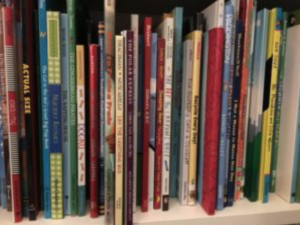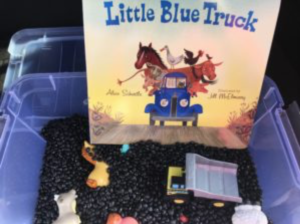Reading is one of my favorite ways to spend time. That includes reading myself as well as reading to my children. Not only do I enjoy the story but the extra snuggles are wonderful too!
Reading aloud to children is one of the best ways to promote language development. It builds vocabulary. It teach es sequencing (beginning/middle/end; problem-solution-result). Syntax. Word structure. Body language. Intonation. Rhyming. The list could go on and on. It also helps children learn their sounds to develop articulate speech.
es sequencing (beginning/middle/end; problem-solution-result). Syntax. Word structure. Body language. Intonation. Rhyming. The list could go on and on. It also helps children learn their sounds to develop articulate speech.
I plan literacy-based sessions frequently, especially for the youngest of my clients. It provides a context to whatever we may be working on in speech therapy and gives them practice with their skill in a real-life occurrence. This helps with carrying the skill we practice in speech therapy to other areas of life, such asat home, in the classroom, in the car, talking to peers at lunchtime and pretty much everywhere.
Tip 1: Be animated
Get into character. Emphasize the right tone and cadence of the story. Listeners find this more engaging and they are learning more about language and communication. They can learn about sarcasm and humor. They also learn about communication presentation, which we all know makes a huge difference in pretty much anything we do.
Tip 2: Read and re-read
Don’t be afraid to read a story over and over again. All the research shows re-reading greatly enhances a child’s comprehension, increases vocabulary, improves reading/story fluency, advances decoding skills and allows them to learn new elements of the story they may not have caught the first time through.
Tip 3: Take the time to talk about it
Have discussions about the story, the characters, the words, the emotions, the humor, etc. This is a big part of where vocabulary development happens. Answer your child’s questions to enhance their understanding. Expand on your answer to give another context or example of when a particular word would be used. Explain the character’s perspective and why he or she might be feeling a particular way. Relate that feeling to your child and a time when they felt the same emotion. Build the connections between the storyline and their life.
When I plan literacy-based therapy sessions, I incorporate toys and/or visuals for the students to interact with after the story. The picture here includes a recent sensory bin I created for one of my favorite books, Little Blue Truck. The theme of the book is about being  kind and respectful to everyone. We discuss the characters (a bunch of farm animals, an initially impatient and rude dump truck, a friendly pickup truck), the actions of the dump truck and their impact on him and the farm animals, the ultimate outcome of working together to achieve more. It’s loaded with common sight words but also has a variety of more spicy vocabulary to introduce and discuss.
kind and respectful to everyone. We discuss the characters (a bunch of farm animals, an initially impatient and rude dump truck, a friendly pickup truck), the actions of the dump truck and their impact on him and the farm animals, the ultimate outcome of working together to achieve more. It’s loaded with common sight words but also has a variety of more spicy vocabulary to introduce and discuss.
I’d love to hear about what books are favorites in your house. Please share below. I’m always looking for new books!
Have questions about speech and language development or literacy, contact Speech With Sara at 313-815-7916 or by email. Speech With Sara offers individual therapy for speech-sound disorders, early childhood language delays, literacy & language deficits and orofacial myofunctional disorders.
